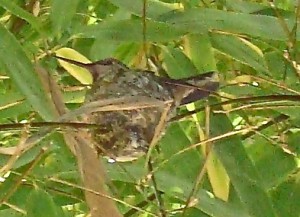
We’ve had a terribly hard spring – a new software system being not the least of our troubles – working 7 days a week for multiple weeks, 10 and 12 hour days every day and not much end in sight. Then a sweet little gift – a hummingbird has decided to build her nest in the bamboo right outside of our door. From our position behind the cash register, Mike and I had both noticed a hummer zipping up into the bamboo quite frequently. So I stood out in the courtyard for a few minutes to try and see what a hummingbird could possibly want in a stand of bamboo. In she flew with a wad of moss in her beak and landed right on a little walnut sized nest. It’s been nice to watch her building and then lining the nest, but even more fun to share the experience with our customers. What a special treat to be able to see a hummingbird and her nest so very close – she’s only about 10 or 11 feet above us, in a nice spot – we can see her and point her out so easily. When she leaves to go eat, we can dash upstairs and peek into the nest to see the two little eggs she laid two weeks ago on a Sunday and Monday, smaller than Jelly Bellies. We should be seeing babies anytime in the next few days.
A few facts about Anna’s Hummingbirds (and a few photos of her eggs): They seem to be fairly common in the Portland area and are easily attracted to feeders. I often hear them before I see them – their call is easy to identify once you’ve heard it – kind of a a squeaking, grating, rapid little noise, given from a perch. They’re green on top and greyish below – the males are distinct from other hummers as they are the only ones with red foreheads as well as throats (the books call it red, but I see it as a metallic deep pink color, compared to the true red of a ruby throat). The females have more of a pink spot on their throat than other species. Their nests are a little cup made with plant down, moss, and lichen, bound together with spider webs, and lined with feather down.
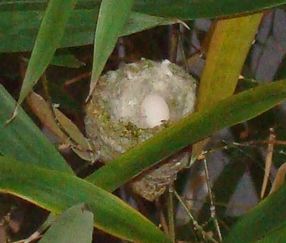
The first egg. photo property of Green Dog Pet Supply
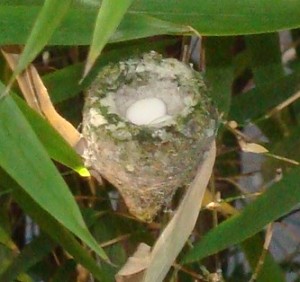
2 eggs in nest. Photo property of Green Dog Pet Supply
The female does all of the work of nest building, incubation, and raising of the babies. She sits on eggs from 14-19 days, and babies fledge about 18-23 days after hatching. It was really interesting to notice that the nest was fairly shallow when she laid the eggs, and the whole time she’s been sitting on them, she’s been also adding moss and lichen to the edges of the nest, making it deeper and deeper. Now the walls are much higher, giving it a lot more room for babies to fit in there as they grow. We are eagerly anticipating the hatching – it’s been 17 days since she laid the first egg, so we know it should be any time between now and Friday. Stop by soon and we’ll point her out to you. If this brood goes well, she will probably lay another clutch in this same area.
Update – later that afternoon, we had our first hatchling! Here’s a terrible photo – couldn’t even zoom in before mom was back and feeling very uncomfortable about us watching her – we backed way off, but could still see her feed it briefly before we ducked out completely:
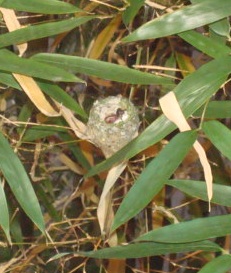
First photo of first nestling. Photo property Green Dog Pet Supply
The next day we had nestling #2 hatch, right on schedule! Both seem to be doing well.
Day 3 photo – Here’s a better (but not great) photo of nestling#1 on day 3 (you can see its mostly naked body, its big eyes (closed for now) and yellow beak (short for now but will grow longer). It’s at least twice the weight it was when it hatched:
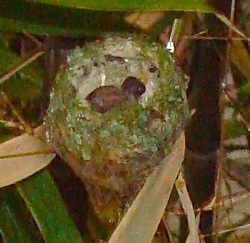
can see first nestling – #2 is up against the nearest nest wall so can’t see it here
Check out this slow motion video of a ruby throated hummingbird in flight (most N. American hummers flap at about 53 wingbeats per second.) hummingbird in flight
This is a good link to Hummer info and some neat photos of Anna’s chicks in a nest in their photo gallery http://www.hummingbirds.net/index.html
Some people have asked why we don’t put a feeder in the courtyard for her. The answer is because we don’t want to attract other hummers to the courtyard to bother her (they’re extremely territorial), and there is already a feeder across the street that she can visit. Also, at this age the nestlings are being fed mainly insects, not nectar.
See the next entry about these babies here

